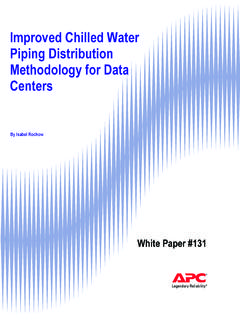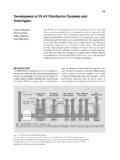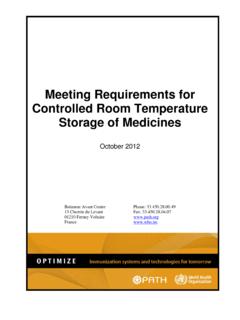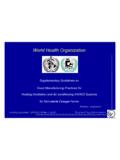Transcription of NOT FOR SALE OR DISTRIBUTION © Jones & …
1 After completing this chapter, the student should be able to:Learning Objectives2 Framework for Professional Nursing PracticeKathleen Masters1. Identify the four metaparadigm concepts of Identify and describe several theoretical works in Begin the process of identifying theoretical frameworks of nursing that are consistent with a personal belief the beginning of nursing theory development can be traced to Florence Nightingale, it was not until the second half of the 1900s that nurs-ing theory caught the attention of nursing as a discipline. During the decades of the 1960s and 1970s, theory development was a major topic of discussion and publication. During the 1970s, much of the discussion was related to the development of one global theory for nursing.
2 However, in the 1980s, atten-tion turned from the development of a global theory for nursing as scholars began to recognize multiple approaches to theory development in of the plurality in nursing theory, this information must be orga-nized to be meaningful for practice, research, and further knowledge devel-opment. The goal of this chapter is to present an organized and practical overview of the major concepts, models, philosophies, and theories that are essential in professional nursing can be helpful to define some terms that might be unfamiliar. A concept is a term or label that describes a phenomenon (Meleis, 2004). The phenom-enon described by a concept can be either empirical or abstract. An empirical concept is one that can be either observed or experienced through the senses.
3 An abstract concept is one that is not observable, such as hope or caring (Hickman, 2002).Key Terms and Concepts Concept Conceptual model Propositions Assumptions Theory Metaparadigm Person Environment Health Nursing 4722/09/12 1:12 PM Jones & Bartlett Learning, LLC. NOT FOR SALE OR DISTRIBUTION . Jones & Bartlett Learning, LLCNOT FOR SALE OR DISTRIBUTION Jones & Bartlett Learning, LLCNOT FOR SALE OR DISTRIBUTION Jones & Bartlett Learning, LLCNOT FOR SALE OR DISTRIBUTION Jones & Bartlett Learning, LLCNOT FOR SALE OR DISTRIBUTION Jones & Bartlett Learning, LLCNOT FOR SALE OR DISTRIBUTION Jones & Bartlett Learning, LLCNOT FOR SALE OR DISTRIBUTION Jones & Bartlett Learning, LLCNOT FOR SALE OR DISTRIBUTION Jones & Bartlett Learning, LLCNOT FOR SALE OR DISTRIBUTION Jones & Bartlett Learning, LLCNOT FOR SALE OR DISTRIBUTION Jones & Bartlett Learning, LLCNOT FOR SALE OR DISTRIBUTION Jones & Bartlett Learning, LLCNOT FOR SALE OR DISTRIBUTION Jones & Bartlett Learning.
4 LLCNOT FOR SALE OR DISTRIBUTION Jones & Bartlett Learning, LLCNOT FOR SALE OR DISTRIBUTION Jones & Bartlett Learning, LLCNOT FOR SALE OR DISTRIBUTION Jones & Bartlett Learning, LLCNOT FOR SALE OR DISTRIBUTION Jones & Bartlett Learning, LLCNOT FOR SALE OR DISTRIBUTION Jones & Bartlett Learning, LLCNOT FOR SALE OR DISTRIBUTION Jones & Bartlett Learning, LLCNOT FOR SALE OR DISTRIBUTION Jones & Bartlett Learning, LLCNOT FOR SALE OR DISTRIBUTION Jones & Bartlett Learning, LLCNOT FOR SALE OR DISTRIBUTIONA conceptual model is defined as a set of concepts and statements that integrate the concepts into a meaningful configuration (Lippitt, 1973; as cited in Fawcett, 1994). Propositions are statements that describe relationships among events, situations, or actions (Meleis, 2004).
5 Assumptions also describe concepts or connect two concepts and represent values, beliefs, or goals. When assumptions are challenged, they become propositions (Meleis, 2004).Conceptual models are composed of abstract and general concepts and propositions that provide a frame of reference for members of a discipline. This frame of reference determines how the world is viewed by members of a discipline and guides the members as they propose questions and make observations relevant to the discipline (Fawcett, 1994).A theory is an organized, coherent, and systematic articulation of a set of statements related to significant questions in a discipline that are com-municated in a meaningful whole, according to Meleis (2007, p.)
6 37). The primary distinction between a conceptual model and a theory is the level of abstraction and specificity. A conceptual model is a highly abstract system of global concepts and linking statements. A theory, in contrast, deals with one or more specific, concrete concepts and propositions (Fawcett, 1994).A metaparadigm is the most global perspective of a discipline and acts as an encapsulating unit, or framework, within which the more restricted .. structures develop (Eckberg & Hill, 1979, p. 927). Each discipline singles out phenomena of interest that it will deal with in a unique manner. The concepts and propositions that identify and interrelate these phenomena are even more abstract than those in the conceptual models.
7 These are the concepts that comprise the metaparadigm of the discipline (Fawcett, 1994).The conceptual models and theories of nursing represent various para-digms derived from the metaparadigm of the discipline of nursing. Therefore, although each of the conceptual models might link and define the four metaparadigm concepts differently, the four metaparadigm concepts are present in each of the central concepts of the discipline of nursing are person, environment, health, and nursing. These four con-cepts of the metaparadigm of nursing are more specifically The person receiving the nursing, the environment within which the person exits, the health illness continuum within which the person falls at the time of the interaction with the nurse, and, finally, nursing actions themselves (Flaskerud & Holloran, 1980, cited in Fawcett, 1994, p.)
8 5).Because concepts are so abstract at the metaparadigm level, many concep-tual models have developed from the metaparadigm of nursing. Subsequently, multiple theories have been derived from each conceptual model in an effort to describe, explain, and predict the phenomena within the conceptual models and theories of nursing represent various paradigms derived from the metaparadigm of the discipline of ChaPTer 2 Framework for Professional Nursing 4822/09/12 1:12 PM Jones & Bartlett Learning, LLC. NOT FOR SALE OR DISTRIBUTION . Jones & Bartlett Learning, LLCNOT FOR SALE OR DISTRIBUTION Jones & Bartlett Learning, LLCNOT FOR SALE OR DISTRIBUTION Jones & Bartlett Learning, LLCNOT FOR SALE OR DISTRIBUTION Jones & Bartlett Learning, LLCNOT FOR SALE OR DISTRIBUTION Jones & Bartlett Learning, LLCNOT FOR SALE OR DISTRIBUTION Jones & Bartlett Learning, LLCNOT FOR SALE OR DISTRIBUTION Jones & Bartlett Learning, LLCNOT FOR SALE OR DISTRIBUTION Jones & Bartlett Learning, LLCNOT FOR SALE OR DISTRIBUTION Jones & Bartlett Learning, LLCNOT FOR SALE OR DISTRIBUTION Jones & Bartlett Learning, LLCNOT FOR SALE OR DISTRIBUTION Jones & Bartlett Learning, LLCNOT FOR SALE OR DISTRIBUTION Jones & Bartlett Learning.
9 LLCNOT FOR SALE OR DISTRIBUTION Jones & Bartlett Learning, LLCNOT FOR SALE OR DISTRIBUTION Jones & Bartlett Learning, LLCNOT FOR SALE OR DISTRIBUTION Jones & Bartlett Learning, LLCNOT FOR SALE OR DISTRIBUTION Jones & Bartlett Learning, LLCNOT FOR SALE OR DISTRIBUTION Jones & Bartlett Learning, LLCNOT FOR SALE OR DISTRIBUTION Jones & Bartlett Learning, LLCNOT FOR SALE OR DISTRIBUTION Jones & Bartlett Learning, LLCNOT FOR SALE OR DISTRIBUTION Jones & Bartlett Learning, LLCNOT FOR SALE OR DISTRIBUTIONO verview of Selected Nursing TheoriesTo apply nursing theory in practice, the nurse must have some knowledge of the theoretical works of the nursing profession. This chapter is not intended to provide an in-depth analysis of each of the theoretical works in nursing but rather provides an introductory overview of selected theoretical works to give you a launching point for further reflection and study as you begin your journey into professional nursing works in nursing are generally categorized either as philosophies, conceptual models, theories, or middle-range theories depending on the level of abstrac-tion.
10 We begin with the most abstract of these theoretical works, the philosophies of nursing. Selected Philosophies of NursingPhilosophies set forth the general meaning of nursing and nursing phenom-ena through reasoning and the logical presentation of ideas. Philosophies are broad and address general ideas about nursing. Because of their breadth, nurs-ing philosophy contributes to the discipline by providing direction, clarifying values, and forming a foundation for theory development (Alligood, 2006).Nightingale s Environmental TheoryNightingale s philosophy includes the four metaparadigm concepts of nursing (Table 2-1), but the focus is primarily on the patient and the environment, with the nurse manipulating the environment to enhance patient recovery.















